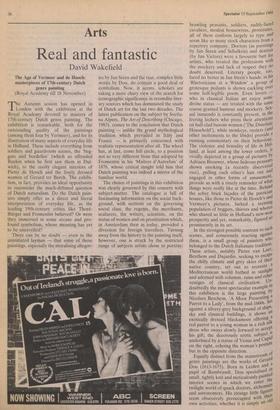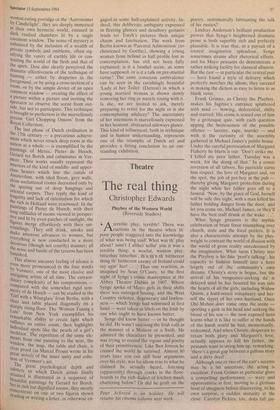Arts
Real and fantastic
David Wakefield
The Age of Vermeer and de Hooch: masterpieces of 17th-century Dutch genre painting (Royal Academy till 18 November)
The Autumn season has opened in London with the exhibition at the Royal Academy devoted to masters of 17th-century Dutch genre painting. The exhibition is remarkable, both for the outstanding quality of the paintings (among them four by Vermeer), and for its illustration of many aspects of everyday life in Holland. These include everything from soldiers and guardroom scenes, the 'beg- gars and bordellos' (which so offended Ruskin when he first saw them at Dul- wich), to the coolly elegant interiors of Pieter de Hooch and the finely dressed women of Gerard ter Borch. the exhibi- tion, in fact, provides an ideal opportunity to reconsider the much-debated question of Dutch naturalism. Do the Dutch pain- ters simply offer us a direct and literal interpretation of everyday life, as the leading 19th-century critics like Thor& Burger and Fromentin believed? Or were they immersed in some arcane and pro- found symbolism, whose meaning has yet to be unravelled?
There can be no doubt — even to the uninitiated layman — that some of these paintings, especially the moralising allegor-
ies by Jan Steen and the taut, complex little works by Dou, do contain a good deal of symbolism. Now, it seems, scholars are taking a more chary view of the search for iconographic significance in recondite liter- ary sources which has dominated the study of Dutch art for the last two decades. The latest publication on the subject by Svetla- na Alpers, The Art of Describing (Chicago, 1983), comes to the conclusion that Dutch painting — unlike the grand mythological tradition which prevailed in Italy and France — is primarily concerned with realistic representation after all. The wheel has, at last, come full circle, to a position not so very different from that adopted by Fromentin in his 'Maitres d'Autrefois' of 1876, whose critical insight told him that Dutch painting was indeed a mirror of the familiar world.
The choice of paintings in this exhibition was clearly governed by this concern with subject-matter. The catalogue is full of fascinating information on the social back- ground, with sections on the governing social class, the regents, the merchants, seafarers, the writers, scientists, on the status of women and on prostitution which, in Amsterdam then as today, provided a diversion for foreign travellers. Turning away from the history to the painting itself, however, one is struck by the restricted range of subjects artists chose to portray:
brawling peasants, ,soldiers, ruddy-faced cavaliers, modest housewives, prostitutes. all of them conform largely to type and seem like so many stock characters from a repertory company. Doctors (in paintings by Jan Steen and Schalken) and dentists (by Jan Victors) were a favourite butt for artists, who treated the professions with the mockery and lack of respect they no doubt deserved. Literary people, too. fared no better in Jan Steen's hands; in his 'Rhetoricians at a Window' a group of grotesque pedants is shown cackling over some half-legible poem. Even lovers who in classical Italian art enjoy semi- divine status — are treated with the same coarse-grained humour and mockery. Sex- ual innuendo is constantly present, in the leering lechers who press their attentions on half-clad buxom women (`The Dissolute Household'), while monkeys, oysters (and other incitements to the libido) provide a running commentary on their behaviour. The violence and brutality of life in WI' land, at least among the lower orders, is vividly depicted in a group of pictures by Adriaen Brouwer, whose hideous peasants shown smoking (a recently discovered vice), pulling each other's hair out and • engaged in other forms of amusement, provide us with a timely reminder of what things were really like at the time. Behind the sober brick facades of the patrician houses, like those in Pieter de Hooch's and Vermeer's pictures, lurked a teeming population of beggars, thieves and whores who shared so little in Holland's new-vvo° prosperity and yet, remarkably, figured s° prominently in its art.
In the strongest possible contrast to such
scenes, and consciously reacting against them, is a small group of painters who belonged to the Dutch Italianate tradition. These artists, notably Pieter van Laer, Berchem and Dujardin, seeking to escape the chilly climate and grey skies of their native country, set out to recreate a Mediterranean world bathed in sunlight and adorned with columns, ruins and other vestiges of classical civilisation. till, doubtedly the most spectacular example in this exhibition is the large painting °Y Nicolaes Berchem, 'A Moor Presenting 3 Parrot to a Lady', from the mid-1660s. Set against a silvery-grey background of ships' sky and classical buildings, it shows a° exotically dressed blackamoor offering ,3 red parrot to a young woman in a rich 5i13 dress who sways slowly forward to accept his gift; the decorously erotic subject ts. underlined by a statue of Venus and Cupid on the right, echoing the woman's posture but in the opposite direction. Equally distinct from the mainstream of genre paintings are the works of Gerard Dou (1613-1675). Born in Leiden and 3 pupil of Rembrandt, Dou specialised i°small, tightly knit and meticulously painted the twilight scenes in which we enter t"e ,. twilight world of quack doctors, alchemist' and astronomers. His strange little figure.' " seem obsessively preoccupied with the,t, own activities; whether it is simply an ol°
woman eating porridge or the 'Astronomer by Candlelight', they are deeply immersed in their own hermetic world, encased in dark vaulted chambers lit by a single casement window. The sense of mystery is enhanced by the inclusion of a wealth of private symbols and emblems, often sig- nifying the vanity of earthly life or con- trasting the world of the flesh and that of the spirit. Dou also clearly perceived the dramatic effectiveness of the technique of framing — either by draperies in the foreground, or by using a cross-section,of a room, or by the simple device of an open casement window — creating the effect of a picture within a picture and inviting the spectator to observe the scene from out- side, but not to participate. This technique is brought to perfection in the marvellously precise 'Girl Chopping Onions' from the Royal Collection.
The last phase of Dutch civilisation in the 17th century — a precarious achieve- ment which never struck deep roots in the nation as a whole — is exemplified by the Paintings of Metsu, Pieter de Hooch, Gerard ter Borch and culminates in Ver- meer. Their works usually represent the interiors of the kind of middle- and upper- class houses which line the canals of Amsterdam, with tiled floors, grey walls, clean uncluttered rooms decorated only by the sparing use of deep hangings and oriental carpets. They typify the kind of frugality and lack of ostentation for which the rich in Holland were renowned. In the Paintings of Pieter de Hooch, with their long enfilades of rooms viewed in perspec- tive and lit by even patches of sunlight, the figures merge effortlessly with their sur- roundings. They still drink, smoke and make amorous advances to women, but everything is now conducted in a more decorous (though not courtly) manner; all the noise and bustle of the taverns has been banished.
This almost uncanny feeling of silence is even more pronounced in the four works by Vermeer, one of the most elusive and intriguing artists of all time. The extraor- dinary complexity of his compositions compared with the somewhat rigid sym- metry of de Hooch — can be studied in the Girl with a Wineglass' from Berlin, with a chair and table placed diagonally on a steeply rising floor. The 'Woman Tuning a Lute' from New York exemplifies his remarkable ability to create light which suffuses an entire room, then highlights individual spots like the pearls of a girl's necklace. The repetition of the same ele- ments from one painting to the next, the window, the map, the table and chair, is clear proof (as Marcel Proust wrote in his great novel) of the inner unity and cohe- sion of Vermeer's art.
The great psychological depth and subtlety to which Dutch artists finally attained is illustrated in a sequence of beautiful paintings by Gerard ter Borch. Set in rich but dignified rooms, they mostly
concentrate on one or two figures shown reading or writing a letter, or otherwise en- gaged in some half-explained activity. In- deed, this deliberate ambiguity expressed in fleeting glances and desultory gestures lends ter Torch's pictures their unique charm and fascination. The work from Berlin known as 'Parental Admonition' (so christened by Goethe), showing a young woman from behind in half profile lost in contemplation, has still not been fully explained; is it a brothel scene, as some have supposed, or is it a talk on pre-marital virtue? The same conscious ambivalence can be seen in the ravishingly beautiful 'Lady at her Toilet' (Detroit) in which a young married woman is shown slowly removing her ring or merely toying with it. Is she, we are invited to ask, merely preparing to retire for the night or is she contemplating adultery? The uncertainty of her intentions is marvellously expressed in her hesitant, abstracted sideways glance. This kind of refinement, both in technique and in human understanding, represents one of the triumphs of Dutch art and provides a fitting conclusion to an out- standing exhibition.



















































 Previous page
Previous page